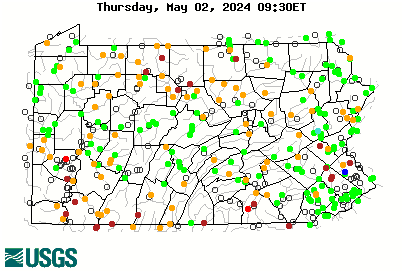The news reported the Cicada left the scene!
You are using an out of date browser. It may not display this or other websites correctly.
You should upgrade or use an alternative browser.
You should upgrade or use an alternative browser.
Chasing the Cicadas
- Thread starter jifigz
- Start date
mt_flyfisher
Well-known member
Sometimes it can be hit or miss trying find the hatch. But this one was a hit and run.The news reported the Cicada left the scene!
td566
Active member
Looked for them in NW Bedford County yesterday. I’m pretty sure we saw them here in 2008. Did not see or hear any. Had a fun day nevertheless.
dryflyguy
Well-known member
They were in Bedford county in 2021Looked for them in NW Bedford County yesterday. I’m pretty sure we saw them here in 2008. Did not see or hear any. Had a fun day nevertheless.
wgmiller
Well-known member
This is a pretty good map that shows where the different broods emerge. Obviously it's not as clear as following county lines, etc. Also, each emergence has "stragglers" who in following years who didn't get the memo to emerge, mate, and die.

dudemanspecial
Well-known member
Is there a scientific reason the current brood in central PA is confined so such a small area?
wgmiller
Well-known member
I found some good info on Wikipedia:Is there a scientific reason the current brood in central PA is confined so such a small area?
Evolution and speciation
See also: Allochronic speciationNot only are the periodical cicada life cycles curious for their use of the prime numbers 13 or 17, but their evolution is also intricately tied to one- and four-year changes in their life cycles. One-year changes are less common than four-year changes and are probably tied to variation in local climatic conditions. Four-year early and late emergences are common and involve a much larger proportion of the population than one-year changes. The different species are well-understood to have originated from a process of allochronic speciation, in which species subpopulations that are isolated from one another in time eventually become reproductively isolated as well.
Research suggests that in extant periodical cicadas, the 13- and 17-year life cycles evolved at least eight different times in the last 4 million years and that different species with identical life cycles developed their overlapping geographic distribution by synchronizing their life cycles to the existing dominant populations. The same study estimates that the Decim species group split from the common ancestor of the Decula plus Cassini species groups around 4 million years ago (Mya). At around 2.5 Mya, the Cassini and Decula groups split from each other.
The Sota et al. (2013) paper also calculates that the first separation of extant 13-year cicadas from 17-year cicadas took place in the Decim group about 530,000 years ago when the southern M. tredecim split from the northern M. septendecim. The second noteworthy event took place about 320,000 years ago with the split of the western Cassini group from its conspecifics to the east. The Decim and the Decula clades experienced similar western splits, but these are estimated to have taken place 270,000 and 230,000 years ago, respectively. The 13- and 17-year splits in Cassini and Decula took place after these events.
The 17-year cicadas largely occupy formerly glaciated territory, and as a result their phylogeographic relationships reflect the effects of repeated contraction into glacial refugia (small islands of suitable habitat) and subsequent re-expansion during multiple interglacial periods. In each species group, Decim, Cassini, and Decula, the signature of the glacial periods is manifested in three phylogeographic genetic subdivisions: one subgroup east of the Appalachians, one midwestern, and one on the far western edge of their range.
The Sota et al. data suggest that the founders of the southern 13-year cicada populations originated from the Decim group. These were later joined by Cassini originating from the western Cassini clade and Decula originating from eastern, middle, and western Decula clades. As Cassini and Decula invaded the south, they became synchronized with the resident M. tredecim. These Cassini and Decula are known as M. tredecassini and M. tredecula. More data is needed to lend support to this hypothesis and others hypotheses related to more recent 13- and 17-year splits involving M. neotredecim and M. tredecim.




